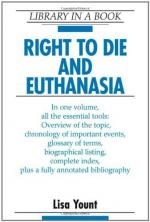|
This section contains 2,869 words (approx. 10 pages at 300 words per page) |

|
Euthanasia
Summary: There are five main categories of the practice of euthanasia: indirect, direct, voluntary, non-voluntary, and involuntary. The main reason for euthanasia would have to reside upon the unbearable pain of the patient. However, as the painkillers are constantly developing in our world today, the pro side of euthanasia is proportionally weakened.
"I will not give no deadly medicine to any one if asked, nor suggest any such counsel"1 clearly states The Hippocratic Oath by the Greek physician Hippocrates, the Father of Medicine, 400 B.C. This is the first recorded attempt to sustain human life in any case whatsoever. During the Washington v. Glucksberg in 1997, where the U.S. Supreme Court upheld the banning of assisted suicide debate, Chief Justice William Rehnquist stated. "More specifically, for over 700 years, the Anglo American common law tradition has punished or otherwise disapproved of both suicide and assisting suicide."2 Today, euthanasia is what we call the "painless killing of a patient suffering from an incurable and painful disease or in an irreversible coma."3 The word euthanasia itself came from a Greek expression of "good death." Whether euthanasia is in fact a "good" death, as the Greeks would have put it, has been argued for...
|
This section contains 2,869 words (approx. 10 pages at 300 words per page) |

|


